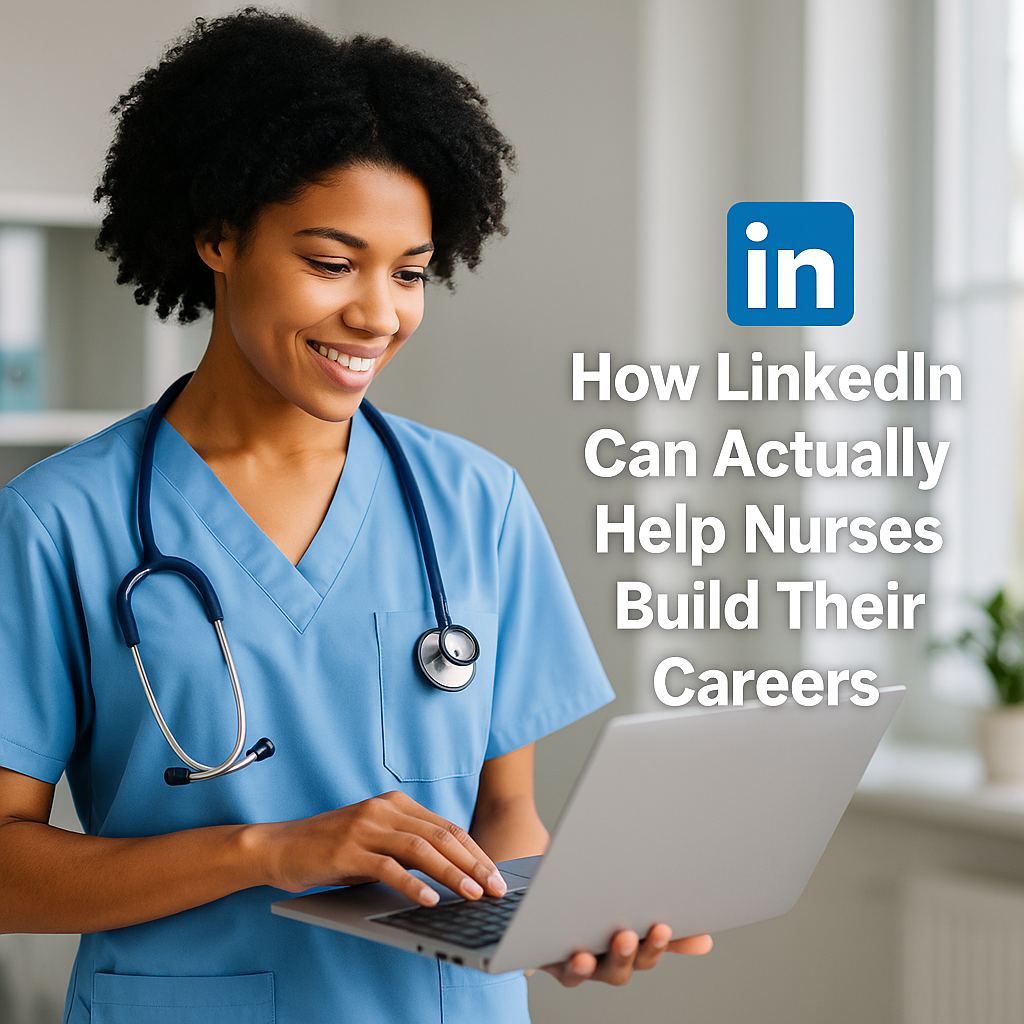If you’re a nurse, chances are you’ve thought LinkedIn is just for business people in suits who say things like “synergy” and “circle back.” But here’s the truth: LinkedIn is one of the most powerful career tools for nurses in 2025.
Whether you’re a new grad trying to stand out, a mid-career nurse looking to pivot into non-bedside roles (compliance, education, informatics, case management), or a seasoned RN ready to step into leadership, LinkedIn can make a real difference.
And yes — recruiters, nurse managers, and hospital HR teams really do search LinkedIn before interviews.
This guide will show you exactly how LinkedIn can help nurses build their careers with practical tips for standing out, networking effectively, and catching recruiter attention. And because this is NurseThoughts, we’ll sprinkle in a little humor along the way.
👉 Focus Keywords: LinkedIn for nurses, nursing career growth, nurse networking, recruiter visibility, nurse LinkedIn profile tips.
Why Nurses Should Care About LinkedIn
The American Nurses Association (ANA) emphasizes professional development as part of lifelong nursing practice. In 2025, professional identity doesn’t just live on your badge — it also lives online.
The Bureau of Labor Statistics (BLS) projects a steady 6% growth in nursing jobs through 2032, with rising demand for advanced practice, leadership, and non-bedside roles. Many of those jobs aren’t found on Indeed — they’re filled through networking and recruiter outreach.
Meanwhile, a Jobvite Recruiter Nation Report revealed that 87% of recruiters use LinkedIn to find candidates. Translation: if your LinkedIn is blank, outdated, or nonexistent, you’re invisible to opportunities.
💡 Humor Take: Think of LinkedIn like a dating app, but for your career. If your profile says nothing but “nurse,” don’t be surprised when nobody swipes right.
Step 1: Build a LinkedIn Profile That Works for Nurses
Your profile is your digital first impression. Here’s how to build one that actually gets noticed.
1.1 Headline = More Than Just “Registered Nurse”
Your headline is prime real estate. Instead of just “RN,” use something keyword-rich:
- “Registered Nurse | ICU, Procedural, and Compliance Experience”
- “Nurse Educator | MSN, CNE | Building the Next Generation of Nurses”
- “Occupational Health RN | Employee Wellness | OSHA Compliance”
Recruiters search by keywords. If you don’t include them, you won’t show up.
Authority Tip: According to LinkedIn’s Talent Blog, profiles with keyword-optimized headlines get 3x more visibility.
1.2 Profile Photo and Banner
- Photo: Professional headshot (not a car selfie in scrubs with a latte). Smile, look approachable.
- Banner: Add a nursing-related image or motivational quote. Example: a stethoscope graphic, or “Advancing Patient Care Through Education.”
1.3 About Section = Your Elevator Pitch
Keep it conversational but professional. Highlight:
- Who you are: “BSN-prepared nurse with 10+ years in ICU and procedural units.”
- What you do well: “Expert in patient advocacy, compliance training, and process improvement.”
- Where you’re going: “Exploring leadership and policy roles in healthcare compliance.”
💡 Pro-tip: End with a human note. Recruiters like personality. “Outside of nursing, I love teaching, mentoring, and chasing my two kids around soccer fields.”
1.4 Experience & Education
- Use bullet points with outcomes. Example:
- “Led fall-prevention initiative that reduced incidents by 30% in 6 months.”
- “Served as charge nurse on a 30-bed ICU, coordinating staffing and emergency response.”
- Education: Include certifications like CCRN, CNE, CHC, OCN.
1.5 Skills & Endorsements
- Add relevant skills (Patient Advocacy, Clinical Education, Compliance, Informatics).
- Endorse colleagues, and they’ll endorse back.
1.6 Recommendations
These are LinkedIn’s “letters of reference.” Ask preceptors, managers, or coworkers to write a few sentences.
Step 2: Networking for Nurses (Without Feeling Awkward)
Networking doesn’t mean spamming people with “hire me” messages. It means building authentic professional relationships.
2.1 Connect Strategically
- Nursing classmates, preceptors, faculty.
- Colleagues from every unit you’ve worked on.
- Nurse leaders, educators, compliance officers, and recruiters.
💡 Fun fact: According to LinkedIn, 70% of jobs are found through networking.
2.2 Join Nursing Groups
Examples:
- American Nurses Association Group
- Nursing Educators Network
- Nurse Leaders and Compliance Professionals
- Regional/state nurse networking groups
Engage with discussions, share articles, and comment with insight. This is how people notice you.
2.3 Share Content (Even If You’re Not a “Content Creator”)
Post once or twice a month:
- Share an article from CDC on infection prevention.
- Comment on a BLS report about nursing growth.
- Reflect on your mentorship journey.
Even a short post like, “Proud to complete my CCRN certification this month — grateful for my ICU team’s support” shows you’re engaged in growth.
2.4 Message Etiquette
If you want to connect with a recruiter or leader:
- Personalize the request: “Hi, I’m an RN exploring compliance roles. I admire your work and would love to connect.”
- Don’t lead with “Can you get me a job?” — that comes later, naturally.
Step 3: Visibility to Recruiters
If your goal is career advancement, visibility matters.
3.1 Turn On “Open to Work”
LinkedIn lets you privately signal to recruiters that you’re looking.
3.2 Keywords in Your Profile
Recruiters search by specialty: “ICU RN,” “Case Management Nurse,” “Compliance Nurse.” Add these keywords naturally throughout your profile.
3.3 Engage Weekly
Commenting on posts = visibility. Each comment shows up in your network’s feed.
3.4 Follow Healthcare Employers
Follow hospitals, universities, and companies. Recruiters notice engaged candidates.
Step 4: Career Moves Nurses Can Make with LinkedIn
Here are roles where LinkedIn can actually make or break your visibility:
- Travel Nursing: Agencies recruit heavily on LinkedIn.
- Education: Nursing schools look for educators and mentors.
- Compliance: Hospitals and universities post compliance roles on LinkedIn first.
- Case Management: Insurance and hospital systems seek experienced RNs for UR/CM roles.
- Informatics: Tech-driven roles often recruit directly from LinkedIn.
- Leadership: Directors, CNOs, and administrators actively network on LinkedIn.
Step 5: Nurse Humor + LinkedIn Reality
Because let’s be real — LinkedIn isn’t always perfect.
- Recruiter: “We have the perfect job for you!”
Job: night shift med-surg, two hours away. - Profile photos: 50% serious headshots, 50% blurry badge pics from 2008.
- Buzzwords: If we had a dollar for every “results-driven professional passionate about healthcare excellence,” we could pay off student loans.
💡 But here’s the thing: even if it feels awkward, it works.
Final Thoughts
LinkedIn isn’t just for corporate types. It’s for nurses too. From building a professional brand to networking with leaders, sharing expertise, and being visible to recruiters, LinkedIn can open doors you didn’t even know existed.
In 2025, nursing isn’t just about surviving the next shift — it’s about building a career that’s sustainable, rewarding, and aligned with your goals. And LinkedIn is one of the tools that can get you there.
So go ahead — update that headline, add your certifications, and start connecting. Your future nurse leader self will thank you.





